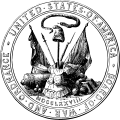XIII Corps (Union Army)
| XIII Corps | |
|---|---|
| Active | 1862–1865 |
| Type | Edward O.C. Ord |
This article relies largely or entirely on a single source. (May 2014) |
XIII Corps was a
Corps History
Creation
The XIII Corps, along with the
Because of the corps' immense size and the fact that it was virtually synonymous with the Army of the Tennessee, Grant chose to subdivide the corps into the Right, Left and Center wings. In December 1862 it was officially divided into the XIII Corps, XV Corps, XVI Corps and XVII Corps. Grant remained in command of the Army of the Tennessee and John A. McClernand assumed command of the XIII Corps. Before the official order was passed along to all the wing commanders, William T. Sherman, commander of the Right Wing, embarked on an expedition against Vicksburg. Sherman's wing of the XIII Corps fought the Battle of Chickasaw Bayou on December 26–29. Although the official date which the Right Wing was designated the XV Corps was December 22, most of the reports regarding the battle at Chickasaw Bluffs still refer to the Union forces as part of the XIII Corps. No matter the designation, it was the first time many of the troops had been under fire.
Arkansas Post
Adding to the identity crisis the XIII Corps faced in its early years was John A. McClernand's expedition against Fort Hindman at Arkansas Post. McClernand was given his XIII Corps and Sherman's XV Corps (now officially using that designation). McClernand labeled these forces the
Vicksburg
With the impending campaign against Vicksburg, Grant took personal command of the operation. McClernand returned to corps command and the Army of the Mississippi was merged back into the Army of the Tennessee and the XIII Corps took on its official title. As the Vicksburg campaign opened the XIII Corps was composed of the 9th, 10th, 11th, 12th, 13th and 14th Divisions commanded respectively by Osterhaus,
The Battle of Port Gibson was fought by the XIII Corps, with the aid of a portion of the XVII Corps. McClernand did not bring the full force of the corps to bear at the Battle of Champion Hill but Hovey's division led the attack on the Confederate right. Immediately following the victory at Champion's Hill the Battle of Big Black River Bridge was again fought exclusively by the XIII Corps, Carr's division bearing the brunt of the fight.
When Grant initiated siege operations the XIII Corps took up a position on the Union left. During the assaults on Vicksburg the XIII Corps lost nearly 1,500 soldiers.
McClernand had been a long time thorn in Grant's side and on June 19, Grant found an opportunity to remove him from command. His replacement was
Texas and Louisiana
After the fall of Jackson the corps returned to Vicksburg and then transferred to the Department of the Gulf. The District of Eastern Arkansas had been detached from the Corps; AJ Smith had been reassigned to command a post in Tennessee; Osterhaus had been reassigned to command a division in the XV Corps; Hovey took leave of the army due to the death of his wife; two of the divisions in the field were consolidated under the command of Cadwallader C. Washburn; and General Herron's division was attached.
General Banks used the XIII Corps to conduct his coastal campaign against Texas during the fall of 1863, capturing Brownsville. By February 1864 corps headquarters were in Texas and General McClernand had returned to command.
Red River
The 1st and 2nd Divisions remained in Texas but
Mobile
The corps was discontinued on June 11, 1864. On February 18, 1865 it was reorganized under the command of
The men of the XIII Corps were never designated an official corps badge[vague] and therefore never wore any form of a corps badge during the war.

